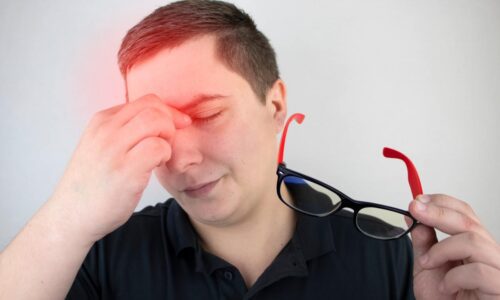What can I do for a scratched eye? |

When someone talks about “scratching” their eye, they are usually referring to an injury to the cornea. The cornea is the clear dome-shaped structure that covers the front of the eye. The cornea protects underlying eye structures (iris, lens, etc.) from injury and helps to focus images on the light-sensing portion of the eye (retina). A cut, scratch, or scrape to the surface of the cornea is known as a corneal abrasion.
How do corneal abrasions occur? Some of the most common ways that the cornea becomes injured include:
- Particles such as sand, sawdust or insects getting into the front of the eye beneath the lid
- Poking the eye with a fingernail or tree branch.
- Being hit with a piece of projectile metal.
- Caustic chemicals splashing into the eye.
- Leaving a contact lens in too long or injury from a poorly-fitting contact lens.
- Lack of protection to the eye while under general anesthesia for surgeryry
What are the symptoms of a corneal abrasion? Symptoms of corneal abrasion include pain, sensitivity to light, blurry vision, and the sensation of something being in the eye. Often the eye becomes bloodshot along with excessive tear production. Because the cornea has a dense
concentration of sensory nerves that are important in its role in protecting the eye, corneal abrasions can be extremely painful.
How are corneal abrasions diagnosed? A common way that doctors use to visualize abrasions is to instill a drop or two of a dye called fluorescein into the eye. The dye will pool in the corneal defect and glow bright green when a cobalt blue light is shined on the eye. A magnifying instrument called a slit lamp is sometimes used for more thorough evaluation of the injury.
How are corneal abrasions treated? Most corneal abrasions turn out to be fairly minor injuries. Nevertheless, it is important that a suspected corneal abrasion be evaluated by a health care professional. This allows the seriousness of the injury to be established as well as determining the most appropriate treatment. While patching the eye has been a traditional treatment for corneal abrasions, more recent research indicates that most can be effectively treated without the use of a patch. Depending on the size and general health of the cornea, most abrasions heal in 1-5 days. In certain instances, the use of antibiotic eye drops or ointment may be advised to prevent an infection. Contact lens wearers should not put in lenses until the abrasion is healed or the problem caused by the contact lens is resolved.
What should you do if you suspect a corneal abrasion? As mentioned, it is best to seek medical attention if you suspect that you have a corneal abrasion. Prior to seeing a doctor you should:
- Rinse the eye with clean water or saline solution using an eye-cup or small drinking glass. Many schools or work site have an eye-rinse station for this purpose.
- Blink several times to help remove small particles of dust or sand.
- Pull the upper eyelid over the lower eyelid. Your lower eyelash may be able to brush away something stuck to the underside of your upper eyelid.
- Refrain from rubbing the eye after an injury since this can worsen a corneal abrasion
- Avoid the use cotton swabs or other instruments to try to remove an embedded foreign object
To prevent corneal abrasions it is recommended that protective eye-wear be worn when working with tools, chemicals, or playing sports that could cause an eye injury. Contact lens wearers should make sure that the lenses fit properly and are used as directed. The great majority of corneal abrasions heal without long-term consequences. More serious scratches or abrasions that are not appropriately treated, however, can lead to serious complications such as corneal erosions or scarring of the cornea.
If you have any more questions just Ask Hanna, our health advisors are here to help.
Image: ©Shutterstock / ARZTSAMUI








